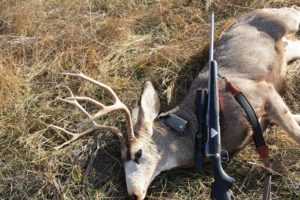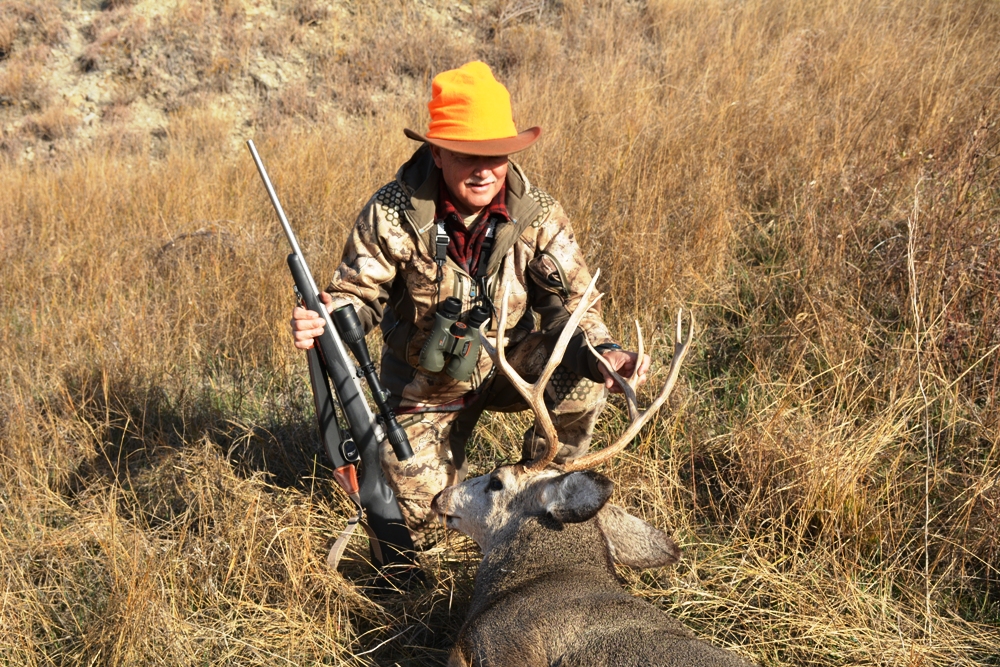The big mule deer buck stood against a background of sage and offered a perfect broadside shot. As I belly crawled the final 50 yards, I finally got a solid reading on the range at 267 yards, not a chip shot, yet one that was make-able with a solid rest. Unfortunately, I had abandoned my backpack to expedite the stalk and now wished mightily for that accuracy asset. Still below the horizon I removed my Pnuma jacket, rolled it into a tight ball and pushed it forward, pausing behind a large yucca plant. My rifle was sighted in at 200 yards and I anticipated a slight drop at longer distance. Although I hadn’t spotted a doe, I was sure that this breeding buck had a doe tucked into a small cedar patch, the reason it continued to hold ground instead of fleeing. The Savage Model 16 is a traditional bolt action rifle and I was confident that it would perform at longer range, especially with the 6.5 Creedmoor 140-grain Fusion bullet. Elevating the reticle high on the shoulder, I exhaled half a breath and squeezed. The rifle recoiled and I saw the buck dash downward and quickly fall, nearly an instant kill. chambering another round, I watched the downed buck carefully for a full minute before heading toward it, still alert to its potential escape.

Reaching the buck, I was thrilled to see that it as a 4×4 with antlers the length of its legs. I’m sure there were larger bucks in the great planes, yet I consider “the shot” to be a significant part of any trophy scenario. I’d spotted the animal at long distance, made a direct stalk, crawled into a solid prone shooting position, and made the shot exactly as planned. The rifle and bullet had worked to perfection, resulting in nearly 100 pounds of venison for the winter. Shooting like a sniper isn’t always an option, yet when a long range scenario presents itself, keep these 10 tips from Bob Robb in mind:
Tom Maciak is an engineer for Trijicon and designs many of the company’s top riflescopes. He’s also an accomplished long-range shooter who taught me and some Special Forces heroes how to be better rifle shots in Utah a couple of years ago. Talk about a humbling experience on all fronts! Still, I walked away a much better shooter following the “Zen Master’s” 10 steps to success. Here they are:
1. RIFLE/LOAD COMBO
The foundation is a rifle/load combination that is consistently accurate. Forget about bullet speed, it’s all about accuracy and using bullets with as high a Ballistic Coefficient (BC) as possible
“



















![The Best Deer Camp Chili [VIDEO] Deer Chili Ingredients, Tomatoes, Chili Spices](/wp-content/uploads/2015/10/Deer-Chili-Deer-Camp-Recipe-218x150.jpg)
![How to Call Elk Early in the Season [VIDEO]](/wp-content/uploads/2016/08/byers003-218x150.jpg)




![Idiots Disturb Hunter: How Would You Have Handled It? [VIDEO]](/wp-content/uploads/2015/10/DSC00110-e1474487693878-100x70.jpg)
![Albino Buck Shocked to Shed His Antlers [VIDEO]](/wp-content/uploads/2015/10/AlbinoDeer-100x70.jpg)